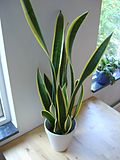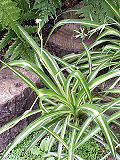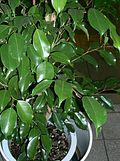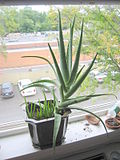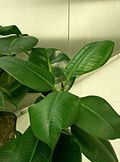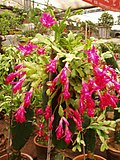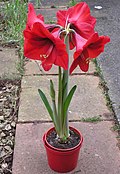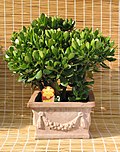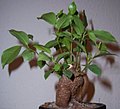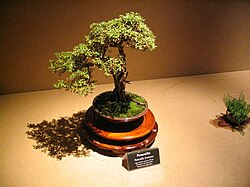AY Honors/House Plants/Answer Key
1. Name at least five house plants raised for their foliage.
2. Name three house plants raised for their flowers.
3. Name three house plants adapted to direct sunlight, dry soils, and very moist soils.
House plants adapted to direct sunlight
- 567px-Alpenveilchen Cyclamen 1.jpg
Cyclamen persicum (Cyclamen)
House plants adapted to dry soils
House plants adapted to very moist soils
4.Most house plants like a 65-to 75-degree (18 C - 22 C) temperature. Name one that requires a cool room (45 to 55 degrees F.) (7 C - 13 C).
The cyclamen commonly sold by florists is C. persicum, which is frost-tender. Selected cyclamen cultivars can have white, bright pink, red or purple flowers. While flowering, florists' cyclamens should be kept below 68 °F (20 °C, 293 kelvins), with the night time temperatures preferably between 44 °F to 59 °F (6.67 °C to 15 °C). Temperatures above 68 °F (20 °C) may induce the plant to go dormant.
5.Prepare a special potting mix soil including at least 3 different ingredients. Select two house plants from requirement two and grow them in this soil for three weeks.
6.How much light does an African violet need? Where in the house is the best place to grow them? Grow two or more African violets.
7.All gesneriads need approximately the same growing conditions. Where do they come from originally? What kind of temperature, light, and humidity do they need?
Saintpaulia, commonly known as African violet, is a genus of 6 species of herbaceous perennial flowering plants in the family Gesneriaceae, native to Tanzania and adjacent southeastern Kenya in eastern tropical Africa, with a concentration of species in the Nguru mountains of Tanzania.
African violets prefer a constant temperature between 20-25 °C (68-77 °F) with high humidity, and thrive best planted in well-drained humus or coir compost.
8.Name two house plants that can be propagated from leaves, stem sections or divisions. Select one plant from requirement two above, experiment with each of these methods of propagation and keep them growing for three months.
9. What is a Bonsai?
Bonsai is the art of aesthetic miniaturization of trees by growing them in containers. Cultivation includes techniques for shaping, watering, and repotting in various styles of containers. The word bonsai has been used in the West as an umbrella term for all miniature trees.
10. What is humidity? How is it important to house plants?
Humidity is the amount of water vapor in the air. The term "humidity" is usually taken in daily language to refer to relative humidity. Relative humidity is defined as the amount of water vapor in a sample of air compared to the maximum amount of water vapor the air can hold at any specific temperature in a form of 0 to 100%.
Humidity, along with temperature, moisture, light, soil mixture, fertilizers, potting, and pest control, is one of the critical factors that should be considered when caring for a houseplant.
Humidity is slightly more difficult to control than temperature. The more commonly used houseplants have established that they can survive in low humidity environments as long as their roots are kept properly irrigated. Most plants thrive in 80% relative humidity while most homes are usually kept around 20% to 60% relative humidity. Besides buying a humidifier, there are a few things that can be done to increase humidity around houseplants. The most popular methods used to raise the ambient humidity are misting and pebble trays, which are shallow trays covered with pebbles and filled with water that evaporates to increase humidity. Other methods of raising humidity include grouping plants closely together and not placing plants in drafty areas. Misting is somewhat controversial among gardeners, with some that swear by it and others that say it does little to increase humidity around plants.
11. Below is a lists of plants to chose from for requirement five and eight above:
| a. Narcissus b. Aspidistra |
h. Piggy-back plant |
o. Begonia |
